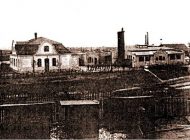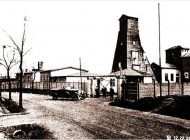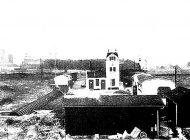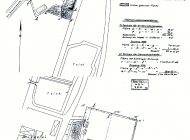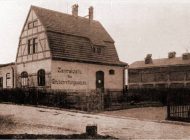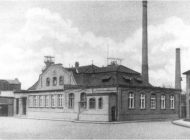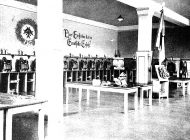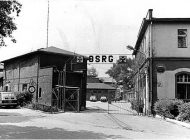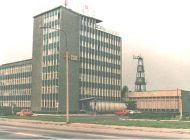In the Upper Silesian Coal Basin the development of the mine rescue took place, as in other countries at the beginning of the twentieth century – after the tragedy in the French coal mine “Courriers” in 1906, which killed 1,100 people. Almost in all mining countries in the world it became an obligation to organize rescue teams in mines and to equip them with breathing apparatus and other emergency equipment.
Since then, the beginnings of the organized mine rescue started.
It has been decided that the mines of the Upper Silesia will be subjected to the central management. Brackie Professional Association, which covered the cost of insurance against accidents in the mines, took this responsibility. On June 26, 1906 during a meeting of the board of Section VI of Brackie Professional Association a decision has been taken concerning the establishment of a centre coordinating and supervising the rescue operations in mines of the Upper Silesian Basin. The construction project of a rescue centre as well as its location in Bytom was decided.
In April 1907, the construction of the centre under the name the “Upper Silesian Main Rescue Station” was started. Its organizer and the first long-term director was an engineer, E. Woltersdorf.
A year later the station started its operations. The scope and operation of the Station in the following years were more and more extended. The development of administrative facilities was started, as well as the construction of specialized laboratories /physical and chemical/, a photometry and photography laboratory, an experimental tunnel.
After the construction of the experimental tunnel in 1911, the Station changed its name to the Upper Silesian Main Mines Rescue Station and Experimental Tunnel. Also, according to current regulations – the station in Bytom was obliged to assist the mines in case of larger emergencies and risks, and therefore, to maintain appropriate eguipment.
In July 1929 the organizational and technical development of the Upper Silesian Main Mines Rescue Station and the Upper Silesian Experimental Tunnel was completed. Also in the same year the permanent Mining Rescue Service in Bytom was established. This station has become the largest mine rescue station in the world.
CHRONOLOGICAL REVIEW
- March 10,1906 – a disaster /coal dust explosion/ in the French coal mine,
- June 26,1906 – at the meeting of the Board of the Section VI of Bracki Professional Association in Tarnów Mountains, a decision was taken to establish the centre for coordinating and supervising rescue operations in the mines of the Upper Silesian region,
- September 22,1906 – the construction project for building the rescue centre as well as its location in Bytom, near the “Heinitz” /Rozbark/ mine was adopted,
- April 1907 – the start of construction of a rescue centre, which was named the “Upper Silesian Main Rescue Station”. The land for the construction was made available by the Mining Company “The Descendants of G. Giesche” at the “Heinitz” mine,
- 1908 – the Upper Silesian Main Rescue Station in Bytom starts its operations,
- 1911 – an experimental tunnel was built at the Upper Silesian Main Rescue Station,
- 1912 – in accordance with the applicable regulations, the station in Bytom was obliged to provide assistance for the mines in case of larger accidents and risks, and thus, to maintain the proper equipment,
- 1929 – the development of the Upper Silesian Main Mines Rescue Station and the Experimental Tunnel in Bytom was completed. The permanent Emergency Rescue was already in service,
- 1939 – the Polish mine rescue was subordinated to the German administration after the outbreak of World War II.
The mine rescue in our coal industry before the outbreak of World War II was located in Mikołów, Sosnowiec, Bytom, Wałbrzych and Łazy. These cities were the training and disposition centres for individual mines. The outbreak of World War II closed the stage of development of the mine rescue in the Upper Silesian coal district.
Polish mine rescue was subordinated to the German administration.
In the Upper Silesian Basin a single mine rescue organization was introduced. The Upper Silesian Main Mines Rescue Station and the Experimental Tunnel in Bytom took the supervision and coordination of all mine rescue services throughout the territory of the occupied Poland.
The activity of the Station in Bytom was stopped only during the bombing of the liberation of the city in 1945.
The first document after the liberation concerning the mine rescue was a letter from the Central Board of Coal Industry in Katowice. In its Circular /published in June 1945/ the concept of the Regional Mines Rescue Station /RMRS/ was introduced, according to which the station in Bytom was one of the regional mine rescue stations /Bytom, Sosnowiec, Mikołów/. Mines were also subjected to individual regional stations, the tasks of RMRS were established as well as the rules of their financing.
- in September 1945 the issue of mutual aid was regulated in the case of a necessary rescue operation in the mine,
- in 1947 the scope of the operations of RMRS Bytom was extended. On 28th November the operations of the permanent Emergency Rescue were started,
- in January 1948 from the Regional Mines Rescue Stations a company called “Mines Rescue Station of the Coal Industry” was set up with the seat in Bytom and divisions in Sosnowiec and Wałbrzych,
- March 9,1959, the existing name of the Station was changed to CENTRAL MINES RESCUE STATION,
- January 1961 – the basic tasks of the Regional and the Central Mines Rescue Station were established,
- December 31, 1962 – the scope of supervision and control for the CMRS was extended with all issues concerning mine rescue in underground mines of the heavy industry:
- in 1963 for mines of chemical raw materials, with the seat in Kłodawa and Rudki near Kielce (closed down in 1972), and in 1972 in Tarnobrzeg – Machów,
- in 1965 for iron ore mines in Częstochowa – Sabin,
- in 1971 for copper mines in Lubin,
- in 1976 for oil and natural gas mines with the seat in Krakow,
- in 1974, due to steadily increasing the range of tasks of the Central Station in Bytom built a new station building,
- 20 May 1981 year round – made more changes in the organization and powers of the Central Station. The novelty was the establishment of the department of mining – mining rescue work consisting of professional rescuers.
Political and economic changes in Poland after 1989 reorganized the whole Polish mining industry, including a number of organizational changes in the CMRS. In 1990 a new organization scheme of the CMRS was established.
The Law of 4 February 1994, “Geological and Mining Law” introduced new legal regulations concerning the obligations of an entrepreneur in mine rescue. Article 75 of this Act provides a constant opportunity to participate in rescue operations of the professional staff of the Central Mines Rescue Station. In 1995, the Decree regulating all issues concerning mine rescue was issued.
As of January 1, 2005 the Central Mines Rescue Station is a Treasury company of particular importance to the national economy. In the Articles of Association, established in 2004 by the Minister of the Treasury, the Central Mines Rescue Station was given the performance of public tasks involving cooperation in carrying out rescue operations and supporting mining plants in the prevention and liquidation of consequences of mining hazards, as well as providing assistance in situations involving a threat to public safety.



